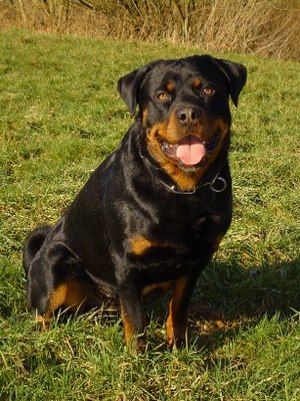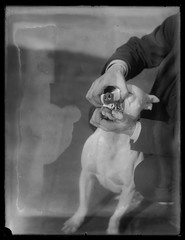 Training Your Dog to Get Along with Cats
Training Your Dog to Get Along with Cats There is a common misconception among some pet owners that dogs and cats cannot co-exist together within a house. While there are some breeds of dogs that do not naturally interact well with other pets most breeds of dogs can be socialized to interact appropriately with cats and live together in a house. The way that the two species are introduced to each other as well as the age of both the dog and cat are key. In addition the pets prior history with the other species really makes a difference as well.
Puppies and cats
If you are considering bringing home a new puppy and you currently have cats there are some steps that you can do to provide the best possible first meeting.
· Keep the puppy separate from the cats for the first few days.
· Allow the cats to smell the blankets that the puppy has slept on and vice versa.
· Hold the puppy and allow the cats to smell him or her without the puppy being able to move towards the cats. This is best done if the puppy is held securely on the floor or on a lap.
· Once they have had a chance to see each other when the puppy is under control consider allowing the puppy to walk around the room with the cats.
· The cats should not be held; rather they should be allowed to move away from the puppy when they want.
· If the puppy barks or attempts to chase the cats correct the puppy with a quick "No" and give them an appropriate toy to play with. Soon the puppy will realize that they are to chew on the toy, not try to chase the cats.
· Supervise all interactions between the cat and puppy until you are confident that they are well socialized. This may take several weeks depending on the comfort level of the cat and the size of the puppy.
Remember the younger this process starts the easier it will be. Keep in mind that some breeds are naturally more aggressive, particularly terriers and other hunting breeds such as Akitas, Dobermans, Rottweilers and hound varieties. Some of the smaller and toy dogs are also not well suited to interacting with cats, so research the breed and talk to current owners and breeders before you choose.
Dogs and cats
If you are considering a mature dog from a rescue or private home be sure to ask if they get along with cats. Most mature dogs that have been properly socialized with cats will get along with all cats after an initial "get to know each other" period. Often this is relatively short, lasting only a couple of days. Some mature dogs do very will with cats in the house but will immediately chase the same cat if they are outside. Carefully monitoring the dog and cat for the first few days is key for both safety and security for the cat and dog.
If you are not sure if the dog is socialized with cats assume that they are not, especially for large breeds of dogs or hunting type dogs including terriers. Keep the dog and the cat separate and only try to introduce them if the dog is on a very short leash and you have another adult there to work with the cat.
Often mature dogs will not interact well with cats but may develop an attitude of ignoring the cat. This may be acceptable but does not mean that the dog may not become aggressive towards the cat under certain conditions. Consider crate training or keeping your dog in a kennel or separate room when you are not able to supervise to prevent any fighting between the two species.
Most breeds of dogs do well with cats, especially when they are introduced slowly and at a young age. Proper socialization with other species will make your dog more accepting of all sorts of animals and will minimize their aggression towards others.
Puppies and cats
If you are considering bringing home a new puppy and you currently have cats there are some steps that you can do to provide the best possible first meeting.
· Keep the puppy separate from the cats for the first few days.
· Allow the cats to smell the blankets that the puppy has slept on and vice versa.
· Hold the puppy and allow the cats to smell him or her without the puppy being able to move towards the cats. This is best done if the puppy is held securely on the floor or on a lap.
· Once they have had a chance to see each other when the puppy is under control consider allowing the puppy to walk around the room with the cats.
· The cats should not be held; rather they should be allowed to move away from the puppy when they want.
· If the puppy barks or attempts to chase the cats correct the puppy with a quick "No" and give them an appropriate toy to play with. Soon the puppy will realize that they are to chew on the toy, not try to chase the cats.
· Supervise all interactions between the cat and puppy until you are confident that they are well socialized. This may take several weeks depending on the comfort level of the cat and the size of the puppy.
Remember the younger this process starts the easier it will be. Keep in mind that some breeds are naturally more aggressive, particularly terriers and other hunting breeds such as Akitas, Dobermans, Rottweilers and hound varieties. Some of the smaller and toy dogs are also not well suited to interacting with cats, so research the breed and talk to current owners and breeders before you choose.
Dogs and cats
If you are considering a mature dog from a rescue or private home be sure to ask if they get along with cats. Most mature dogs that have been properly socialized with cats will get along with all cats after an initial "get to know each other" period. Often this is relatively short, lasting only a couple of days. Some mature dogs do very will with cats in the house but will immediately chase the same cat if they are outside. Carefully monitoring the dog and cat for the first few days is key for both safety and security for the cat and dog.
If you are not sure if the dog is socialized with cats assume that they are not, especially for large breeds of dogs or hunting type dogs including terriers. Keep the dog and the cat separate and only try to introduce them if the dog is on a very short leash and you have another adult there to work with the cat.
Often mature dogs will not interact well with cats but may develop an attitude of ignoring the cat. This may be acceptable but does not mean that the dog may not become aggressive towards the cat under certain conditions. Consider crate training or keeping your dog in a kennel or separate room when you are not able to supervise to prevent any fighting between the two species.
Most breeds of dogs do well with cats, especially when they are introduced slowly and at a young age. Proper socialization with other species will make your dog more accepting of all sorts of animals and will minimize their aggression towards others.




